修辞手法在写作中的应用
修辞手法在作文中的运用与效果
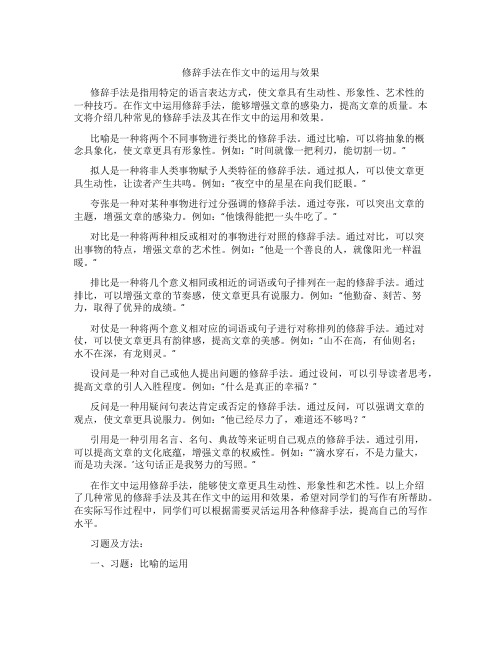
修辞手法在作文中的运用与效果修辞手法是指用特定的语言表达方式,使文章具有生动性、形象性、艺术性的一种技巧。
在作文中运用修辞手法,能够增强文章的感染力,提高文章的质量。
本文将介绍几种常见的修辞手法及其在作文中的运用和效果。
比喻是一种将两个不同事物进行类比的修辞手法。
通过比喻,可以将抽象的概念具象化,使文章更具有形象性。
例如:“时间就像一把利刃,能切割一切。
”拟人是一种将非人类事物赋予人类特征的修辞手法。
通过拟人,可以使文章更具生动性,让读者产生共鸣。
例如:“夜空中的星星在向我们眨眼。
”夸张是一种对某种事物进行过分强调的修辞手法。
通过夸张,可以突出文章的主题,增强文章的感染力。
例如:“他饿得能把一头牛吃了。
”对比是一种将两种相反或相对的事物进行对照的修辞手法。
通过对比,可以突出事物的特点,增强文章的艺术性。
例如:“他是一个善良的人,就像阳光一样温暖。
”排比是一种将几个意义相同或相近的词语或句子排列在一起的修辞手法。
通过排比,可以增强文章的节奏感,使文章更具有说服力。
例如:“他勤奋、刻苦、努力,取得了优异的成绩。
”对仗是一种将两个意义相对应的词语或句子进行对称排列的修辞手法。
通过对仗,可以使文章更具有韵律感,提高文章的美感。
例如:“山不在高,有仙则名;水不在深,有龙则灵。
”设问是一种对自己或他人提出问题的修辞手法。
通过设问,可以引导读者思考,提高文章的引人入胜程度。
例如:“什么是真正的幸福?”反问是一种用疑问句表达肯定或否定的修辞手法。
通过反问,可以强调文章的观点,使文章更具说服力。
例如:“他已经尽力了,难道还不够吗?”引用是一种引用名言、名句、典故等来证明自己观点的修辞手法。
通过引用,可以提高文章的文化底蕴,增强文章的权威性。
例如:“‘滴水穿石,不是力量大,而是功夫深。
’这句话正是我努力的写照。
”在作文中运用修辞手法,能够使文章更具生动性、形象性和艺术性。
以上介绍了几种常见的修辞手法及其在作文中的运用和效果,希望对同学们的写作有所帮助。
修辞手法在写作中的运用与效果分析

修辞手法在写作中的运用与效果分析修辞手法是指在写作中运用特定的语言技巧和艺术手段,以达到表达目的和增强作品感染力的目的。
本文将就修辞手法在写作过程中的运用及其效果进行分析和探讨。
一、修辞手法的定义和分类修辞手法是一种用来增强文学作品感染力的艺术手段,它可以通过运用比喻、排比、设问、夸张等手法来达到表达目的。
常见的修辞手法有比喻与象征、排比与倒装、设问与反问、夸张与略缩等。
二、比喻与象征的运用及效果分析比喻是将两个或多个不同事物进行类比,通过共同点来突出被比喻对象的某种特征或形象。
象征是通过用具体事物来代表抽象概念,以增强作品的意象和表达效果。
三、排比与倒装的运用及效果分析排比是将同一个词、短语或句子按照一定的顺序排列,以增强修辞效果和表达力度。
倒装是指将语序颠倒,使得句子结构更加独特和吸引人。
四、设问与反问的运用及效果分析设问是通过提出问题来引导读者思考,并突出作品的主题和观点。
反问则是一种修辞手法,通过提出与事实相反的问题来表达强烈的否定或讽刺。
五、夸张与略缩的运用及效果分析夸张是通过夸大事物的特征或程度,以突出作品的感染力和表达效果。
略缩则是通过简化叙述和描述,去掉无关紧要的细节,以达到简明扼要的效果。
六、修辞手法在不同文体中的运用及效果分析不同的文体对修辞手法的运用有不同的要求和效果。
在诗歌中,修辞手法经常被用来增强语言的音韵美和意境感。
在散文中,修辞手法则更多地用于表达感情和突出观点。
七、修辞手法的运用与写作技巧修辞手法的运用需要结合具体的写作情境和创作目的,熟练掌握不同的修辞手法并恰当运用于不同的文体和题材中,可以有效提高作品的艺术性和感染力。
八、修辞手法的运用与写作效果对比分析通过对比运用修辞手法和不运用修辞手法的写作效果,可以更加清晰地认识到修辞手法在写作中的重要性和作用。
九、修辞手法的局限性和注意事项修辞手法虽然能增强作品的表达效果和感染力,但过度使用修辞手法可能导致作品过于矫揉造作,失去真实感和自然性。
修辞手法在写作中的应用

修辞手法在写作中的应用修辞手法是一种用于增强语言表达效果和感染力的重要技巧。
在写作中,恰当地运用修辞手法可以使文章更加生动、有趣,给读者留下深刻的印象。
本文将探讨修辞手法在写作中的应用,并举例说明其在不同文体中的运用。
一、修辞手法的分类修辞手法一般可以分为音乐修辞、形象修辞、语义修辞和逻辑修辞四大类。
音乐修辞主要通过音韵、节奏等方式调动读者的听觉感官;形象修辞则通过具体形象的描写展示事物的真实与特点;语义修辞则依靠词语和词组的选择、组合,使句子具有强烈的感染力和艺术性;逻辑修辞则在句子的结构和逻辑关系上进行修辞。
二、修辞手法在散文中的应用散文是一种以记叙、描写和抒发情感为主要特征的文体,对于修辞手法的运用尤为重要。
以夸张为例,夸张可以让文字更富有张力,增强文章的感染力。
比如“我看见了一个笔直入云的高楼”,夸张的修辞让读者对高楼的形象有了更加鲜明的印象。
再如对比,通过对比可以突出事物的差异和对立,加深读者对文章的理解和思考。
例如“黑夜中,寂静无声,我感受到了内心的躁动”,对比的修辞手法让读者感受到了作者内心的矛盾和不安。
三、修辞手法在诗歌中的应用诗歌是一种高度压缩和抒发情感的文学形式,修辞手法在其中的运用尤为突出。
以拟人为例,拟人可以使诗歌更加富有生命力和情感力。
比如“湖水轻轻拍打着岸边的石头”,通过将湖水拟人化,增强了描写的生动性和艺术性。
又如比喻,比喻可以通过两个不同事物的相似之处,带来诗歌的美感和思考。
例如“她像一位少女般婉约”,比喻的修辞手法让诗歌充满了浪漫和情感。
四、修辞手法在故事中的应用故事是一种通过情节展开的叙述方式,修辞手法在其中可以使故事更加生动有趣。
以反问为例,反问可以引起读者的思考和注意力。
例如“是不是一个人的力量可以改变世界?”,反问的修辞手法使读者思考到个体对于世界可能带来的影响。
再如排比,排比可以对事物进行相对比较,突出重点。
例如“她哭了、笑了、跳了起来”,排比的修辞手法使故事中的情节更加生动和夸张。
小学语文写作教学中修辞手法的应用分析
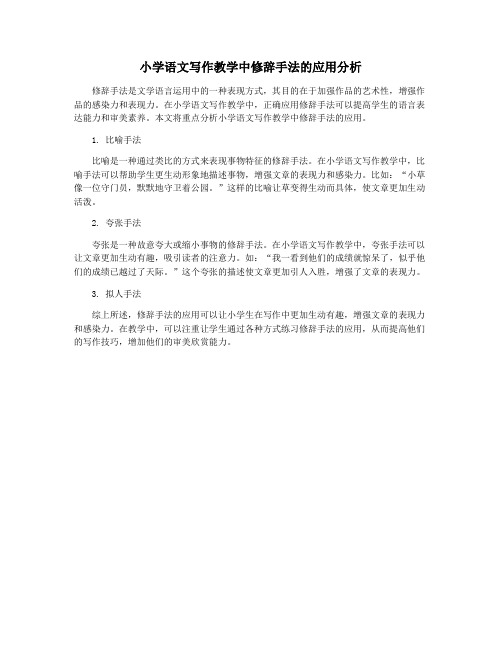
小学语文写作教学中修辞手法的应用分析
修辞手法是文学语言运用中的一种表现方式,其目的在于加强作品的艺术性,增强作品的感染力和表现力。
在小学语文写作教学中,正确应用修辞手法可以提高学生的语言表达能力和审美素养。
本文将重点分析小学语文写作教学中修辞手法的应用。
1. 比喻手法
比喻是一种通过类比的方式来表现事物特征的修辞手法。
在小学语文写作教学中,比喻手法可以帮助学生更生动形象地描述事物,增强文章的表现力和感染力。
比如:“小草像一位守门员,默默地守卫着公园。
”这样的比喻让草变得生动而具体,使文章更加生动活泼。
2. 夸张手法
夸张是一种故意夸大或缩小事物的修辞手法。
在小学语文写作教学中,夸张手法可以让文章更加生动有趣,吸引读者的注意力。
如:“我一看到他们的成绩就惊呆了,似乎他们的成绩已越过了天际。
”这个夸张的描述使文章更加引人入胜,增强了文章的表现力。
3. 拟人手法
综上所述,修辞手法的应用可以让小学生在写作中更加生动有趣,增强文章的表现力和感染力。
在教学中,可以注重让学生通过各种方式练习修辞手法的应用,从而提高他们的写作技巧,增加他们的审美欣赏能力。
修辞手法在写作中的点睛之笔

修辞手法在写作中的点睛之笔修辞手法是一种用于增强文学作品表达力和感染力的技巧,它通过巧妙地运用各种修辞手段,使文字更具艺术性和表现力。
修辞手法在写作中起到了点睛之笔的作用,使作品更加生动、精彩。
本文将探讨修辞手法在写作中的应用和效果。
一、比喻与拟人比喻是一种通过对两个事物之间相似之处的比较来加深读者对特定情感、特征或主题的理解的方法。
拟人则是将非人物赋予人的特点和行为。
比喻和拟人能够让内容更加鲜活有趣,使读者更容易理解和产生共鸣。
例如,我们可以使用比喻来描述一个美丽的风景:“那座山如同一位静谧的守护者,高耸入云,宛如刺破天穹的尖刀。
”通过比喻,读者可以更加形象地感受到山的高大和壮丽,增加了形象的感染力。
二、排比与对偶排比是指将同类或相近的事物按照一定的顺序排列,以增强表达的力度和节奏感。
对偶则是通过把两个相对或相似的词、短语或句子进行并列表达,以增加对比和对立的效果。
例如,我们可以运用排比的修辞手法来强调观点:“她的笑容如阳光般温暖,她的眼睛如夜空中的明星,她的声音如溪水般悦耳。
”通过排比,作者成功地突出了主要内容,使读者更加深刻地感受到了主人公的美丽与魅力。
三、夸张与反问夸张是指对事物进行无限放大或缩小的描述,以突出某种感觉或形象。
反问则是提出一个问题,但不需要得到明确的回答,往往用于表达强烈的感情或加强叙述的效果。
例如,我们可以运用夸张手法来描述一个繁忙的街道:“街道上行人如潮,极度拥堵,无一幸免。
”通过夸张,作者生动地描绘了拥挤繁忙的街景,给读者一种身临其境的感觉。
四、比较与对照比较是一种通过对两个事物的相似或相异之处进行比较来突出其特点或差异的手法。
对照则是把两个事物或情境进行对比,以增强对某一方面的描述或表达。
例如,我们可以通过比较描写季节的变迁:“春天犹如醒来的大地,万物复苏,草木吐绿;夏天像燃烧的烈火,炙烤大地,激活人们的热情;秋天似金黄的诗篇,悄然而至,让人陶醉其中;冬天宛如雪域银装,世界一片纯净。
修辞手法在写作中的应用

修辞手法在写作中的应用修辞手法是一种在文学和写作中广泛运用的技巧,通过巧妙地运用各种修辞手法,可以丰富作品的意境,增强文学效果,并能有效吸引读者的注意力。
在本文中,我们将探讨修辞手法在写作中的应用,以及它们对于作品的影响。
一、比喻和隐喻的运用比喻和隐喻是修辞手法中常用且重要的表达方式。
比喻是通过将一个事物与另一个事物进行类比,以便使读者更好地理解作者的意图。
例如,“他的笑容如阳光般温暖”,这句话通过将笑容与阳光进行比较,形象地描绘出了一个友善热情的形象。
而隐喻则是通过暗示或间接表达来传达某种含义,使文章更具有深意。
例如,“她是一朵盛开在黑暗中的玫瑰”,这句话通过将女主人公与玫瑰进行隐喻,表达了她的美丽和坚强。
二、排比和对偶的运用排比和对偶是修辞手法中常用的句子结构形式。
排比是通过将同类型或相似的词语或短语排列在一起,形成平行的结构,以增强表达的力度。
例如,“春风送暖,夏雨滋润,秋叶飘落,冬雪皑皑”,这句话通过排比的方式,生动地描绘了四季的景象。
而对偶则是通过将两个相对矛盾或对立的词语或短语放在一起,形成鲜明的对比效果。
例如,“爱与恨,生与死,希望与绝望”,这句话通过对偶的方式,突出了两种极端的情感。
三、夸张和反问的运用夸张和反问是修辞手法中常用的表达手段。
夸张是通过夸大或夸张某种事物的特点,以引起读者的共鸣或注意。
例如,“他饭量如同一头饿狼”,这句话通过夸张形容,生动地描绘出了一个人的饭量大的形象。
而反问则是通过提出一个问题,实际上是在暗示着一种肯定或否定的观点。
例如,“难道我们不应该追求自由和平等吗?”这句话通过反问的方式,强调了追求自由和平等的必要性。
四、拟人和拟物的运用拟人和拟物是修辞手法中常见的方法,可以使作品更生动有趣。
拟人是将无生命的事物赋予人类的特征和行为,使其拥有生命力。
例如,“海浪咆哮着冲向岸边”,这句话通过拟人的方式,描绘了海浪的形象。
而拟物则是将人的特征和行为赋予无生命的事物,使其具有人的形象或特点。
修辞手法在写作中的巧妙运用

修辞手法在写作中的巧妙运用修辞手法是作家运用语言艺术的技巧,以达到增强文章感染力、表达能力的目的。
它可以使作品更加生动、形象,促使读者产生共鸣。
本文将重点分析修辞手法在写作中的巧妙运用。
一、比喻的巧妙运用比喻是一种将事物与事物进行比较的修辞手法。
通过使用比喻,作家可以将抽象的概念转化为具体的形象,使得文章更加直观。
比如,《红楼梦》中林黛玉“比金陵小旦,又如年少素女”一词,将黛玉的美貌与戏曲形象巧妙地结合起来。
二、拟人的巧妙运用拟人是一种将无生命的事物赋予人的特质的修辞手法。
通过拟人,作家可以使作品更加生动有趣,增强读者的阅读体验。
例如,在《离骚》中,屈原将大河比作“黄河之水天上来”,生动地描绘了大自然的壮丽与浩渺。
三、夸张的巧妙运用夸张是一种通过夸大事物的特征来加强语气和感染力的修辞手法。
作家可以运用夸张手法来强调某种感觉或效果,吸引读者的注意力。
例如,在杜甫的《登高》中,他写道:“风急天高猿啸哀,渚清沙白鸟飞回。
”通过夸张的手法,强调了自然景色的壮丽和震撼。
四、对偶的巧妙运用对偶是一种通过对比和平衡的修辞手法,使文章更加凝练、精炼。
对偶的运用使得文章的结构更加清晰,读者也更易于理解。
例如,《红楼梦》开篇的“悲喜交集,离合悲欢”,通过对偶的手法,展现了世事无常、喜怒哀乐交织的人生境遇。
五、排比的巧妙运用排比是一种通过将同类事物、同类词语等进行并列以便于突出某个特定意思或形象的修辞手法。
排比运用可以使文章更加紧凑、有节奏感,增强文章的表现力。
例如,“我站在这个土地上,我自豪;我生活在这个时代,我自豪;我为我的祖国骄傲。
”六、反复的巧妙运用反复是一种通过重复运用某种语句、词语等以强调某种意义的修辞手法。
反复的运用可以使文章更加印象深刻、思想更加深入人心。
例如,在马克吐温的《哈克贝利·费恩历险记》中,反复使用“无知真是美好”的句式,以表达对社会现象的批判。
在修辞手法的巧妙运用中,作家可以使用上述几种手法的综合与组合,以达到更好的效果。
修辞手法在写作中的实际运用
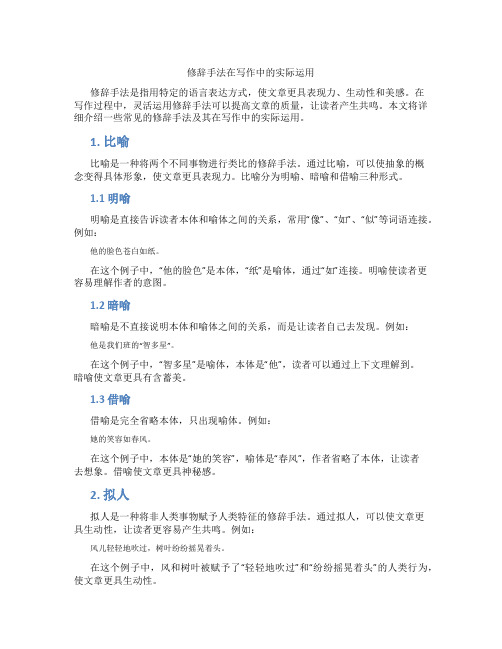
修辞手法在写作中的实际运用修辞手法是指用特定的语言表达方式,使文章更具表现力、生动性和美感。
在写作过程中,灵活运用修辞手法可以提高文章的质量,让读者产生共鸣。
本文将详细介绍一些常见的修辞手法及其在写作中的实际运用。
1. 比喻比喻是一种将两个不同事物进行类比的修辞手法。
通过比喻,可以使抽象的概念变得具体形象,使文章更具表现力。
比喻分为明喻、暗喻和借喻三种形式。
1.1 明喻明喻是直接告诉读者本体和喻体之间的关系,常用“像”、“如”、“似”等词语连接。
例如:他的脸色苍白如纸。
在这个例子中,“他的脸色”是本体,“纸”是喻体,通过“如”连接。
明喻使读者更容易理解作者的意图。
1.2 暗喻暗喻是不直接说明本体和喻体之间的关系,而是让读者自己去发现。
例如:他是我们班的“智多星”。
在这个例子中,“智多星”是喻体,本体是“他”,读者可以通过上下文理解到。
暗喻使文章更具有含蓄美。
1.3 借喻借喻是完全省略本体,只出现喻体。
例如:她的笑容如春风。
在这个例子中,本体是“她的笑容”,喻体是“春风”,作者省略了本体,让读者去想象。
借喻使文章更具神秘感。
2. 拟人拟人是一种将非人类事物赋予人类特征的修辞手法。
通过拟人,可以使文章更具生动性,让读者更容易产生共鸣。
例如:风儿轻轻地吹过,树叶纷纷摇晃着头。
在这个例子中,风和树叶被赋予了“轻轻地吹过”和“纷纷摇晃着头”的人类行为,使文章更具生动性。
3. 夸张夸张是一种对事物的特点进行夸大的修辞手法。
通过夸张,可以突出事物的特点,增强文章的表现力。
例如:他饿得可以把一头牛吃下去。
在这个例子中,作者将他的饥饿程度夸张为“可以把一头牛吃下去”,使读者更能感受到他的饥饿感。
4. 反问反问是一种用疑问句表达肯定或否定的修辞手法。
通过反问,可以加强语气,引起读者的思考。
例如:这难道不是最美的风景吗?在这个例子中,作者通过反问表达了对这美景的赞叹。
反问使文章更具说服力。
5. 对仗对仗是一种将两个意义相对或相近的词语、句子进行对称排列的修辞手法。
如何在写作中运用丰富的修辞手法来增强文章的表达力和说服力技巧总结

如何在写作中运用丰富的修辞手法来增强文章的表达力和说服力技巧总结在写作中,修辞手法是一种重要的技巧,可以增强文章的表达力和说服力。
通过合理运用各种修辞手法,可以使文章更加生动、有趣,并能够更好地传达作者的观点。
以下是一些常见的修辞手法及其运用技巧的总结:一、比喻比喻是通过将两个本质不同的事物进行比较,来传达具体形象或抽象概念的一种修辞手法。
比喻能够使文章更具形象感,使读者更容易理解和接受作者的观点。
例如,对于一个晴天的描述,可以使用比喻来增强表达力:“今天的天空如同一幅巨大的蓝色画布,洒上了无数朵洁白的云彩,犹如棉花糖一般,让人仿佛置身于梦幻的天堂。
”二、拟人拟人是将无生命的事物赋予人性特征或行为的修辞手法。
通过拟人,可以使作品更富有情感和生动性,让读者更易产生共鸣。
例如,对于大自然的描写,可以使用拟人手法:“大地静静地躺在夜的怀抱中,星星们相互闪烁着眼,月亮害羞地躲在云彩后面,仿佛在和万物共同享受宁静的夜晚。
”三、排比排比是通过将同类或相近的事物、观点或词语并列排列的修辞手法。
排比可以增强表达的力度和节奏感,使文章更富有张力和感染力。
例如,用排比手法来表达时间的流逝:“一年,两年,三年,时间如流水般匆匆而过,转眼之间,我们已经走过了风风雨雨的青春岁月。
”四、夸张夸张是指对某个事物的描述或表达过程中,故意夸大其特征或效果的修辞手法。
适度的夸张可以使文章更具吸引力和趣味性,引起读者的共鸣或注意。
例如,夸张地形容一个人的善良:“他是世界上最善良无私的人,他的心比大海还要宽广,比太阳还要耀眼。
”五、反问反问是指在表达观点或论证过程中,以问题的形式来表达自己的意图或观点的修辞手法。
反问可以引起读者的思考,进而更好地理解和接受作者的观点。
例如,以反问来引起共鸣和思考:“你难道不曾有过一丝疑问吗?这世间是否真的没有奇迹?”综上所述,修辞手法在写作中的运用对于增强文章的表达力和说服力至关重要。
通过恰当地运用比喻、拟人、排比、夸张和反问等修辞手法,可以使文章更具生动性、感染力和说服力。
修辞手法在作文中的运用

修辞手法在作文中的运用修辞手法是作文中的一种重要技巧,通过巧妙地运用修辞手法可以使作文更加生动、精彩。
本文将从比喻、夸张、排比、拟人等方面探讨修辞手法在作文中的运用。
一、比喻的运用比喻是一种常用的修辞手法,通过将两个事物进行类比,以增强作文的表达力。
比喻在作文中可用于形容事物、表达感情等方面。
例如,在描述美丽的风景时,可以使用比喻来增强描写的效果,如“湖水清澈如镜,犹如一面巨大的明镜反射出蓝天白云。
”二、夸张的运用夸张是一种夸大事物特征的修辞手法,在作文中能够夸张表达某一事物的好与坏。
夸张能够引起读者的共鸣,增强作文的表现力。
例如,在描述一个人的美貌时,可以使用夸张手法,如“她阳光般明媚的笑容照亮了整个房间,美得让人仿佛置身于童话世界。
”三、排比的运用排比是一种将两个或多个相同结构的句子进行并列的修辞手法,在作文中可以起到强调、对比、扩大事物意义的作用。
排比能够使作文内容更加丰富多样,同时也更加易于理解。
例如,“她善良、聪明、勇敢,是我心目中完美的榜样。
”四、拟人的运用拟人是一种将无生命的事物赋予人的性格特征和行为的修辞手法,能够增强作文的感染力和形象表现。
通过拟人手法,可以使作文更加生动有趣。
例如,在描写下雨的场景时,可以使用拟人手法,“雨滴嘀嗒着唱起了一首欢快的歌,它们似乎在与大地轻轻地交流着。
”综上所述,修辞手法在作文中的运用可以使作文生动、形象,增强作文的表达力。
比喻、夸张、排比、拟人等修辞手法都是常用的修辞技巧,通过灵活运用这些手法可以使作文更加吸引人。
在写作过程中,我们应该根据具体情境和写作目的选择合适的修辞手法,以使作文更加精彩有趣。
通过不断学习和实践,我们可以不断提高修辞手法的运用水平,写出更加出色的作文作品。
语文写作中的修辞手法运用

语文写作中的修辞手法运用在语文写作中,恰当地运用修辞手法可以使文章更加生动、形象、富有感染力,让读者更容易产生共鸣,留下深刻的印象。
接下来,让我们一起探讨几种常见的修辞手法在写作中的运用。
比喻,是一种最常见也最实用的修辞手法。
它通过将一个事物比作另一个事物,让读者能够更加直观地感受到所描述对象的特点。
比如说,“月亮像一个大圆盘挂在天上”,将月亮比作圆盘,生动形象地展现了月亮的形状和其圆润的特点。
再比如,“她的笑容像春天里绽放的花朵”,通过这样的比喻,我们仿佛能看到她那灿烂、美好的笑容,感受到笑容所带来的温暖和喜悦。
比喻的运用,能够让抽象的事物变得具体,让平淡的描述变得生动有趣。
拟人,赋予非人类的事物以人类的行为、情感或特征,使其具有人的灵性和活力。
例如,“风儿轻轻地抚摸着我的脸庞”,风儿本是自然现象,却被赋予了“抚摸”这一人的动作,让人感受到风的轻柔与亲切。
又如,“小鸟在枝头欢快地歌唱”,小鸟的叫声被形容为歌唱,让整个场景都充满了欢快的氛围。
拟人手法能够拉近读者与所描述对象的距离,使读者更容易产生情感上的共鸣。
夸张,是对事物的特征、形象、作用、程度等进行夸大或缩小的描述,以增强表达效果。
“飞流直下三千尺,疑是银河落九天”,用“三千尺”来形容瀑布的高度,极言其雄伟壮观,给人以强烈的视觉冲击。
“他饿得能吞下一头大象”,通过极度夸张的手法,突出了他的饥饿程度。
夸张手法能够使读者更深刻地感受到作者想要表达的情感和事物的特点。
排比,则是将三个或三个以上结构相似、语气一致、意思相关或相同的句子排列起来。
“爱心是一片照射在冬日的阳光,使贫病交迫的人感到人间的温暖;爱心是一泓出现在沙漠里的泉水,使濒临绝境的人重新看到生活的希望;爱心是一首飘荡在夜空的歌谣,使孤苦无依的人获得心灵的慰藉。
”通过排比,不仅增强了语势,更使得爱心的意义和价值得到了充分的展现,让读者更深刻地理解和感受到爱心的力量。
对比,把两种不同的事物或同一事物的两个不同方面放在一起进行比较。
写作技巧中的修辞手法应用方法
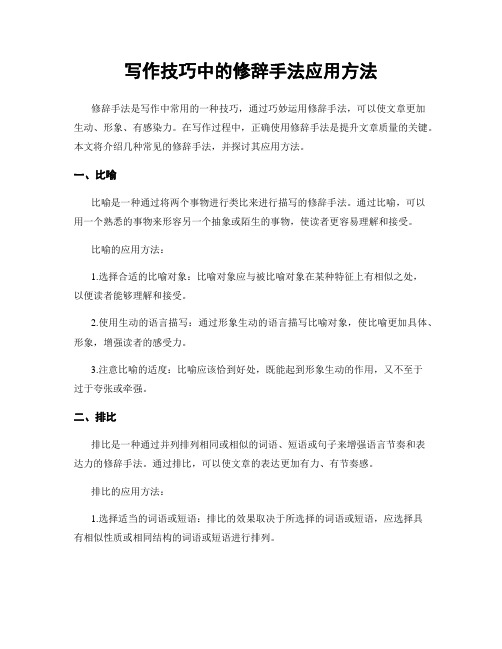
写作技巧中的修辞手法应用方法修辞手法是写作中常用的一种技巧,通过巧妙运用修辞手法,可以使文章更加生动、形象、有感染力。
在写作过程中,正确使用修辞手法是提升文章质量的关键。
本文将介绍几种常见的修辞手法,并探讨其应用方法。
一、比喻比喻是一种通过将两个事物进行类比来进行描写的修辞手法。
通过比喻,可以用一个熟悉的事物来形容另一个抽象或陌生的事物,使读者更容易理解和接受。
比喻的应用方法:1.选择合适的比喻对象:比喻对象应与被比喻对象在某种特征上有相似之处,以便读者能够理解和接受。
2.使用生动的语言描写:通过形象生动的语言描写比喻对象,使比喻更加具体、形象,增强读者的感受力。
3.注意比喻的适度:比喻应该恰到好处,既能起到形象生动的作用,又不至于过于夸张或牵强。
二、排比排比是一种通过并列排列相同或相似的词语、短语或句子来增强语言节奏和表达力的修辞手法。
通过排比,可以使文章的表达更加有力、有节奏感。
排比的应用方法:1.选择适当的词语或短语:排比的效果取决于所选择的词语或短语,应选择具有相似性质或相同结构的词语或短语进行排列。
2.注意节奏感:排比要求词语或短语在语法结构、音韵节奏上保持一致,以增强排比的效果。
3.避免过度使用:排比的使用应适度,过度使用会导致语言繁琐、重复,影响阅读体验。
三、夸张夸张是一种通过对事物进行夸大或缩小处理来达到修辞效果的手法。
夸张可以使文章更加夸张生动、引人入胜,增强表达的力度和感染力。
夸张的应用方法:1.选择适当的修辞对象:夸张对象应具有一定的特殊性或突出的特点,以便夸张处理更加突出。
2.注意适度和真实性:夸张要求适度,过度夸张会显得虚假,失去修辞效果。
同时,夸张的内容应与事实有一定的联系,以保持真实性。
3.运用形象生动的描写:通过生动的语言描写,使夸张更加具体、形象,增强读者的感受力。
四、反问反问是一种通过提出问题来表达自己的观点或强调某种情感的修辞手法。
通过反问,可以使文章更具有互动性、引起读者的思考和共鸣。
修辞手法在小说写作中的应用及艺术效果
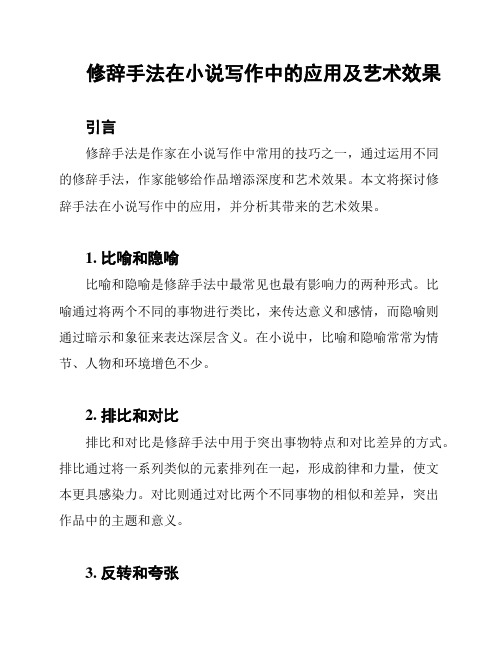
修辞手法在小说写作中的应用及艺术效果
引言
修辞手法是作家在小说写作中常用的技巧之一,通过运用不同
的修辞手法,作家能够给作品增添深度和艺术效果。
本文将探讨修
辞手法在小说写作中的应用,并分析其带来的艺术效果。
1. 比喻和隐喻
比喻和隐喻是修辞手法中最常见也最有影响力的两种形式。
比
喻通过将两个不同的事物进行类比,来传达意义和感情,而隐喻则
通过暗示和象征来表达深层含义。
在小说中,比喻和隐喻常常为情节、人物和环境增色不少。
2. 排比和对比
排比和对比是修辞手法中用于突出事物特点和对比差异的方式。
排比通过将一系列类似的元素排列在一起,形成韵律和力量,使文
本更具感染力。
对比则通过对比两个不同事物的相似和差异,突出
作品中的主题和意义。
3. 反转和夸张
反转和夸张是修辞手法中用于创造戏剧性、鲜明形象和幽默效
果的方法。
反转通过改变人物或情节的预期发展方向,给读者带来
意料之外的结果,增添小说的趣味性。
夸张则通过夸大语言和描述,使描绘更加生动有趣。
4. 拟人和拟物
拟人和拟物是修辞手法中赋予非人事物人类的性格和特征的方式。
通过使用拟人和拟物,作家可以让读者更好地理解和共情。
将
自然界的景物或抽象概念赋予人的行为、情感和意愿,可以增强作
品的艺术效果。
结论
修辞手法在小说写作中是一个非常有用的工具,它能够为作品
带来更为深刻和生动的表达。
比喻和隐喻、排比和对比、反转和夸张、拟人和拟物这些常见的修辞手法,不仅能够增加作品的艺术效果,还能够激发读者的情感共鸣,使作品更加出彩。
修辞手法在写作中的应用

修辞手法在写作中的应用修辞手法是一种艺术性的技巧,用于增强文学作品的表达效果。
在写作中,熟练运用各种修辞手法不仅可以打破单调,增添趣味,还可以使文章更富有感染力。
本文将探讨修辞手法在写作中的应用,并对其效果进行分析。
一、比喻的运用比喻是通过将两个不同的事物进行类比来达到修辞效果的手法。
它能够使抽象的概念更加具体生动,增强读者的形象感知能力。
例如,在描写大海时,可以使用“海浪如同巨人的呼吸”来形容海浪的起伏不定,使读者产生身临其境的感觉。
二、拟人的应用拟人是将非生命的事物赋予生命特征和活动能力的修辞手法。
通过拟人,可以使作品中的事物有血有肉,更容易引起读者的共鸣。
举个例子,在描写树木时,可以写道:“树枝紧紧地拥抱着大地”,形容树木与大地融为一体的情景,让读者感受到自然与人的关系。
三、借代的运用借代是用一个意象来替代另一个意象,以此实现修辞效果的手法。
通过借代,可以简明扼要地表达出复杂的概念,提高文章的逻辑性和表达力。
比如,在描述战争时,可以使用“硝烟弥漫的战场”来代指整个战争过程,让读者一下子明白战争的残酷和恐怖。
四、夸张的应用夸张是夸大叙述事物的实际情况,以夸张手法加强作品的表现力。
适度的夸张能够吸引读者的注意力,激发读者的情感共鸣。
例如,在描写美食时,可以写道:“这道菜有着舌尖的炸裂感,让人忍不住嘴唇湿润”,以此形容美食的诱人程度,让读者产生流口水的感觉。
五、对比的运用对比是通过将两个有明显差异的事物并列在一起,以突出对比的效果的修辞手法。
对比可以更好地展现事物的特点,使文章更加丰满,形象更加鲜明。
比如,在描写孤寂时,可以写道:“寂静的夜晚,寒冷的冬日”,形容孤独和寒冷的对比,使读者能够更加深入地理解孤独所带来的冰冷感。
六、排比的应用排比是将相同结构、相近词义的词语或短语并列使用的修辞手法。
排比可以增强语言的节奏感和表现力,使文章更加流畅、有力。
比如,在讲述成长的过程时,可以写道:“我的成长经历,是爱的滋润,是友谊的陪伴,是挫折的磨砺”,通过排比的方式展示成长所经历的不同阶段,使读者更加深刻地感受到成长的所带来的丰硕果实。
如何在作文中运用修辞手法
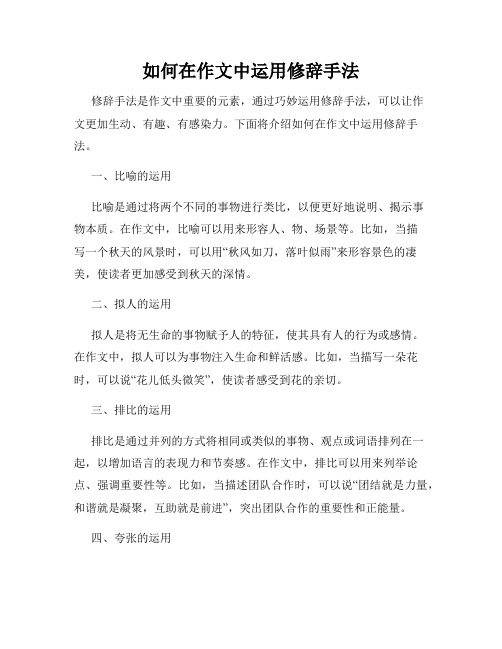
如何在作文中运用修辞手法修辞手法是作文中重要的元素,通过巧妙运用修辞手法,可以让作文更加生动、有趣、有感染力。
下面将介绍如何在作文中运用修辞手法。
一、比喻的运用比喻是通过将两个不同的事物进行类比,以便更好地说明、揭示事物本质。
在作文中,比喻可以用来形容人、物、场景等。
比如,当描写一个秋天的风景时,可以用“秋风如刀,落叶似雨”来形容景色的凄美,使读者更加感受到秋天的深情。
二、拟人的运用拟人是将无生命的事物赋予人的特征,使其具有人的行为或感情。
在作文中,拟人可以为事物注入生命和鲜活感。
比如,当描写一朵花时,可以说“花儿低头微笑”,使读者感受到花的亲切。
三、排比的运用排比是通过并列的方式将相同或类似的事物、观点或词语排列在一起,以增加语言的表现力和节奏感。
在作文中,排比可以用来列举论点、强调重要性等。
比如,当描述团队合作时,可以说“团结就是力量,和谐就是凝聚,互助就是前进”,突出团队合作的重要性和正能量。
四、夸张的运用夸张是对事物进行放大、渲染,以表达情感或强调某种特征。
在作文中,适当运用夸张可以增强表达的效果和感染力。
比如,当形容一个人的高个子时,可以说“他站在人群中,仿佛一座高山般耸立”,营造出一个高大威猛的形象,让人印象深刻。
五、反问的运用反问是以问句的形式来表达肯定或否定的意思,常用于修辞、反驳、强调等。
在作文中,反问可以用来引起读者思考,增加文采和抒情效果。
比如,当讨论环保问题时,可以问:“你们认为地球是我们的家吗?难道我们不应该好好保护她吗?”,既引起了读者对环保问题的思考,又强调了环保的重要性。
六、对比的运用对比是通过将两个或多个事物进行比较,以突出事物的差异或共同之处。
在作文中,对比可以用来展示观点、强化感情等。
比如,当讨论幸福与困难时,可以对比“幸福是甜蜜的果实,困难是崎岖的山路”,让读者更加深刻地理解幸福和困难的不同。
通过以上的介绍,我们可以看到修辞手法在作文中的重要性以及它们的不同运用方式。
修辞手法在作文中的应用

修辞手法在作文中的应用作文,在语言文字表达中具有很大的重要性。
作为一种语言艺术的表达方式,作文需要考虑内容的准确性和语言的魅力。
而修辞手法作为一种提升作文质量的工具,在作文中的应用十分关键。
本文将从比喻、排比、修辞问答等多个方面探讨修辞手法在作文中的应用。
一、比喻的应用比喻是一种修辞手法,通过将两种不同事物相比,以便更好地理解和描述一个事物。
在作文中,比喻能够使描述更加形象生动,增强表达的感染力。
比如在描写自然风景时,可以用比喻手法来传递对大自然的赞美之情:“迎着朝阳,大地犹如一张展开的金色地毯。
”这种比喻的使用,使得作文更加生动有趣,让读者感受到美丽的自然景色。
二、排比的应用排比是一种修辞手法,用于通过相似的结构来表达同时或连续发生的动作或情节。
在作文中,排比能够使文章结构清晰,内容条理分明。
例如,当我们在叙述一个人的成长历程时,可以使用排比手法来呈现不同时期的变化:“在小学,他是阳光般的学生;在中学,他是努力拼搏的青年;而现在,他已经成为一个百尺竿头的佼佼者。
”这个例子中的排比,突出了不同时期的特点,使得作文更具有逻辑性和说服力。
三、修辞问答的应用修辞问答是一种通过提问和回答的方式,来加强论述或抒发情感的修辞手法。
在作文中,修辞问答能够引起读者思考,并通过问题与回答来加深表达的含义。
例如,在叙述一个社会问题时,可以使用修辞问答来引起读者的共鸣:“我们何去何从?是坐以待毙,还是勇敢追求?”这种修辞问答的运用,让读者在思考问题的同时,对问题的重要性有了更深层次的认识。
通过以上几个方面的探讨,我们可以看出修辞手法在作文中的重要性和应用。
比喻、排比和修辞问答等修辞手法的运用,不仅可以增强作文的感染力和说服力,还能够让读者更好地理解和记忆作文的内容。
因此,在写作过程中,我们应该灵活运用各种修辞手法,以增强作文的质量。
总结起来,修辞手法在作文中具有重要的应用价值。
通过比喻、排比和修辞问答等手法的巧妙运用,作文可以更加生动形象,内容更加有逻辑性和说服力。
修辞手法在写作中的运用

修辞手法在写作中的运用修辞手法是指作者在表达思想、感情和意境时所采用的一系列技巧和方法。
它通过巧妙而生动的辞藻、形象和比喻等手段,使作品更具表现力和感染力。
在写作中,修辞手法被广泛运用,可以增强文章的艺术性和说服力。
本文将探讨修辞手法在写作中的运用。
一、比喻比喻是修辞手法中常见且广泛运用的一种手法。
通过将两个或多个事物进行类比,使读者更容易理解和接受作者的观点。
比喻可以使抽象的概念更加具体生动,增强作品的形象感。
例如,在描写美丽的风景时,可以用“如诗如画”来形容,使读者更能感受到美的力量和魅力。
二、夸张夸张是一种夸大事物的手法,常用于幽默和夸张效果的表达。
通过夸张手法,作者可以让读者更加深刻地感受到事物的特点和情感。
例如,在描写一个人的丑陋时,可以使用夸张的手法,如“她的脸上长满了疙瘩,像是一颗颗小山丘”,使读者对这个人的丑陋印象更加深刻。
三、排比排比是将相同或相似的句子结构进行排列,以增强表达的力度和节奏感。
排比可以使文章更加有节奏感,增强语言的力量和表现力。
例如,在描述一个人的品质时,可以使用排比手法,如“他勇敢、坚强、聪明,是一个真正的英雄”。
四、反问反问是一种修辞手法,通过提问来引起读者的思考和共鸣。
反问可以使文章更具说服力和表现力,激发读者的思考。
例如,在写环境保护时,可以使用反问手法,如“我们难道不应该保护我们的家园吗?”,引起读者对环境保护的重要性的思考和关注。
五、比较比较是通过将两个或多个事物进行对比,以突出事物的特点和优劣。
比较可以使文章更具说服力和表现力,帮助读者更好地理解和接受作者的观点。
例如,在写一个人的聪明才智时,可以使用比较手法,如“他的聪明就像是一盏明灯,照亮了整个团队”。
六、拟人拟人是将无生命的事物赋予人的特点和行为的修辞手法。
通过拟人手法,作者可以使作品更具生动感和感染力。
例如,在描写一朵花时,可以使用拟人手法,如“花儿在微风中轻轻摇曳,似乎在向世界展示自己的美丽”。
修辞手法在作文中的独特运用与创新

修辞手法在作文中的独特运用与创新修辞手法是作文中常见的一种技巧,它可以通过巧妙的修辞方法,使作文更加生动、形象,增强表达的感染力和艺术性。
在作文中的应用也是多种多样的,可以用来描写人物、环境、情感等方面,起到提升作文质量的作用。
本文将探讨几种修辞手法在作文中的独特运用与创新。
一、比喻的运用比喻是一种常见的修辞手法,通过运用类比的方法,将不同事物进行联系和比较,以增加作品的表现力。
在作文中,比喻可以用来描写人物的特征、环境的景色、情感的表达等等。
比如,“他的笑容如阳光一般温暖”,这样的比喻可以让读者更加直观地感受到人物的亲和力和善良。
此外,创新的比喻运用也可以给作文带来惊喜和新鲜感。
比如,在叙述一个晴朗的天空的时候,可以尝试使用“天空如同一块巨大的蓝宝石”来形容,这样的比喻使得作文更加有趣且具有美感。
二、拟人的表现拟人是一种将无生命的事物赋予人类特点的修辞手法,通过这种手法,可以使作文更加生动、形象化。
在作文中,可以将一些抽象的东西,如时间、颜色、自然现象等等,赋予具体的人类特征和行为。
例如,“时间百般残忍地将他带走”中的“时间百般残忍”就运用了拟人的手法,使得时间变得具体、有血有肉起来。
同时,创新的拟人也可以让作文更加引人入胜,例如,“黄昏悄悄地走进了村庄,揭开夜晚的面纱,带来了一片寂静的宁静”,通过拟人让黄昏具有了进入、揭开等人类的行为,增强了作文的审美效果。
三、夸张的手法夸张是一种通过放大事物的特点和现象,以产生戏剧性效果的修辞手法。
在作文中,夸张可以用来表达某种感情或者强调某种特征,从而增加作文的感染力。
例如,“他已经等了一万年”中的“一万年”就是夸张的表达,强调了人物等待的时间之长。
此外,创新的夸张可以给作文增添趣味,比如,“他的胃口大得可以一次吞下整个鲸鱼”,这样的描述会让人忍俊不禁,同时也增加了作文的趣味性。
总之,修辞手法在作文中的独特运用与创新可以让作文更加生动、形象,增加其艺术性和感染力。
语文写作中的修辞手法运用

语文写作中的修辞手法运用语文写作是我们学习语言文字的重要一环,而修辞手法则是写作中的一把利器。
修辞手法能够使文章更加生动、有趣,增强语言的表现力。
本文将探讨一些常见的修辞手法及其运用。
一、比喻比喻是一种常见的修辞手法,通过将两个事物进行类比,使得抽象的概念更加具象化。
比喻能够使文章更加形象生动,增强读者的感受力。
例如,在描写美景时,我们可以使用比喻来增强描写的效果:“夕阳如一颗红艳的火球,慢慢沉入大海的怀抱,犹如一位温柔的母亲轻轻哺育着大地。
”通过将夕阳比喻为红艳的火球,大海比喻为温柔的母亲,使得读者能够更加直观地感受到美景的壮丽和温馨。
二、排比排比是一种修辞手法,通过重复使用相同的句式结构或语法结构,来表达强烈的感情或强调某种观点。
排比能够使文章的节奏感更强,让读者更容易理解和接受作者的观点。
例如,在叙述人物形象时,我们可以使用排比来突出人物的特点:“他不仅聪明,而且机智;他不仅勤奋,而且坚韧;他不仅有才华,而且有担当。
”通过使用排比,将人物的特点一一列举出来,使得读者能够更加全面地了解这个人物,增强对人物形象的印象。
三、夸张夸张是一种修辞手法,通过对事物进行夸大或缩小的描写,来达到一种夸张的效果。
夸张能够使文章更加生动有趣,增强表现力。
例如,在描写恐怖场景时,我们可以使用夸张来营造气氛:“黑暗笼罩着整个房间,仿佛吞噬一切光明的怪兽;寂静无声的空气中,传来阵阵诡异的脚步声,像是来自地狱的恶魔。
”通过夸张的描写,使得读者能够更加直观地感受到恐怖氛围,增强阅读的紧张感。
四、反问反问是一种修辞手法,通过提出一个问题,但实际上并不需要对这个问题进行回答,来表达一种观点或强调某种事实。
反问能够使文章更加有说服力,增强表达的效果。
例如,在议论文中,我们可以使用反问来引起读者的思考:“难道我们不应该珍惜眼前的幸福吗?难道我们不应该为了美好的未来而努力吗?”通过反问,引起读者对于珍惜幸福和追求美好未来的思考,增强了文章的说服力。
修辞手法在写作中的运用与创作

修辞手法在写作中的运用与创作修辞手法是一种在写作中运用的艺术技巧,通过巧妙地使用各种修辞手法,能够使文章更富有表现力、更生动有趣。
本文将探讨修辞手法在写作中的运用以及如何应用这些手法进行创作。
一、修辞手法的定义与作用修辞手法是指作者在文字表达中运用的一系列技巧和方法,旨在增强文章的表现力和说服力。
修辞手法能够让语言更具艺术魅力,激发读者的兴趣,让读者更容易理解、接受并记住文章的内容。
修辞手法以其多样性被广泛应用于各类文学作品中,包括散文、诗歌、小说等。
同时,在日常生活和商业领域中,修辞手法也发挥着重要的作用,例如广告宣传、演讲演说等。
二、修辞手法的主要类型及实例1.比喻:将一个事物与另一个事物进行类比,以便更好地说明其特征和特点。
例如:“他是工作中的一颗明星,照亮了整个团队。
”2.拟人:将非人物赋予人的特质和行为,使其更生动有趣。
例如:“花朵在微风中低声诉说着自己的故事。
”3.夸张:夸大某物的特点或情况,以产生强烈表现力和印象。
例如:“这个故事无比精彩,简直让人惊叹不已!”4.对比:通过对比两个相互对立的事物,使其中一个事物更加突出或强调不同之处。
例如:“冬日的阳光与寒冷的空气形成了鲜明的对比。
”5.排比:通过列举相似或对立的事物,使表达更有力量和韵律感。
例如:“我爱你的眼睛,爱你的笑容,更爱你的心。
”6.反讽:用语言表达出与实际相反或截然不同的意义,以达到嘲笑或讽刺的目的。
例如:“这个公司真是件容易赚钱的买卖,它亏本都能赚到钱。
”7.修辞问答:通过提问和回答的方式,引发读者的思考和共鸣。
例如:“你知道吗?那天,星星在等待月亮的到来。
”三、修辞手法的创作应用1.增强形象感染力:在创作中,通过使用比喻、拟人等手法,可以将抽象的概念转化为具体的形象,增加读者的感受和共鸣。
2.营造氛围和情感:通过使用夸张、对比等手法,可以营造出各种氛围和情感,达到情感共鸣的效果,让读者更好地理解和体验。
3.加强逻辑和说服力:通过使用排比、修辞问答等手法,可以使文章的逻辑更加清晰和有力,增强说服力,引导读者思考和接受作者观点。
- 1、下载文档前请自行甄别文档内容的完整性,平台不提供额外的编辑、内容补充、找答案等附加服务。
- 2、"仅部分预览"的文档,不可在线预览部分如存在完整性等问题,可反馈申请退款(可完整预览的文档不适用该条件!)。
- 3、如文档侵犯您的权益,请联系客服反馈,我们会尽快为您处理(人工客服工作时间:9:00-18:30)。
修辞手法在英文写作中的运用教学目标:让学生体会修辞手法在写作中的妙用,教学步骤:Step I Lead -in一篇文章通常可分为三个部分,即开头、正文和结尾。
这三个部分安排是否得体,直接影响到文章的质量。
文章的开头一般来说应尽量做到开门见山,用简单明白的叙述引出文章的话题,使读者了解文章要谈论什么,一下于引起读者的兴趣。
作文常见的开头形式大致有以下几种:1.开门见山,揭示主题文章一开头,,就交待清楚文章的主题是什么。
如“How I Spent My Vacation”(我怎样度假)的开头是:I Spent my last vacation happily.下面是题为"Honesty"(谈诚实)一文中的开头:Honesty is one of the best virtues.An honest man is always trusted and respected.On the contrary, one who tells lies is regarded as a "liar",and is looked upon by honest people.2.交代人物、事情、时间或环境开头在文章的开头,先把人物、事件和环境交待清楚。
例如"A Trip to Jinshan" (去金山旅游)的开头:The day before yesterday my class went on a bus trip to Jinshan. The bus ride there took three hours. The long trip made us very tired, but the sight of the beautiful sea refreshed us.3. 回忆性的开头用回忆的方法来开头。
例如"A Trip to the Taishan Mountain"(泰山游)的开头是:I remember my first trip to the Taishan Mountain as if it were yesterday.4.概括性的开头即对要在文章中叙述的人或事先作一个概括性的介绍。
如“The Happiness of Reading Books”(读书的快乐)的开头:People often say that gold and silver are the most valuable things in the world. But I say that to read books is more valuable than anything else, because books give us knowledge and knowledge gives us power.5.介绍环境式的开头即开头利用自然景物或自然环境引出要介绍的事物。
如“An Accident”(一场事故)的开头是: It was a rainy and windy morning. The sky was gloomy, the temperature was low, and the street was nearly empty. I was on my way back to school. Suddenly, a speeding car came round the corner.6.交待写作目的的开头。
在文章的一开头就交待写作目的,如通过文章要表扬谁,批评谁,或说明一个什么问题等。
如"Pollution Control" (控制污染)的开头:In this article I shall draw your attention to the subject of pollution control.英语作文的文章的结尾________________________________________文章结尾的作用是概括全文内容,进一步强调或肯定文章的中心思想,使文章意义表达得更加深刻。
文章结尾的形式也是多种多样的,常见的有以下几种:1.首尾呼应,画龙点睛在文章的结尾,把含义较深的话放在末尾,以点明主题,深化主题,起到画龙点睛的效果。
如"I Cannot Forget Her" (我忘不了她)的结尾:After her death, I felt as if something were missing in my life. I was sad over her passing away, but I knew she would not have had any regrets at having given her life for the benefit of the people.2.重复主题句结尾回到文章开头阐明的中心思想或主题句上,达到强调的效果。
如“I Love My Home Town”(我爱家乡)的结尾:I love my home town, and I love its people. They too have changed. They are going all out to do more for the good of our motherland.3. 自然结尾随着文章的结束,文章自然而然地结尾。
如“Fishing”(钓鱼)的结尾:I caught as many as twenty fish in two hours, but my brother caught many more. Tired from fishing, we lay down on the river bank, bathing in the sun. We returned home very late.4.含蓄性的结尾用比喻或含蓄的手法不直接点明作者的看法,而是让读者自己去领会和思考。
如“A Day of Harvesting”(收割的日子)的结尾:Evening came before we realized it. We put down our sickles and looked at each other. Our clothes were wet with sweat, but on every face there was a smile.5.用反问结尾虽然形式是问句,但意义却是肯定的,并具有特别的强调作用,引起读者深思。
如"Should We Learn to Do Housework?" (我们要不要学做家务?) 的结尾。
Everyone should learn to do housework. Don't you agree, boys and girls?6.指明方向,激励读者结尾表示对将来的展望,或期待读者投入行动。
如“Let's Go in for Sports”(让我们参加体育运动)的结尾:As we have said above, sports can be of great value. They not only make people live happily but also help people to learn virtues and do their work bettter. A sound mind is in asound body. Let's go in for sports.文章的结尾没有一定的模式,可以根据表达主题的需要灵活创造。
一般的习惯是,一些记叙文和描写文经常采用自然结尾的方法;但说理性和逻辑性较强的说明文和议论文则往往都有结束语,以便使文章首尾呼应,结构完整step II 英文写作中词语的选择1.词语选择的重要性在The Right Word at the Right Time的“序言”中,编者对词语选用的重要性作了一个很好的比喻:“Using the right word at the right time is rather like wearing appropriate clothing for the occasion:it is a courtesy to others,and a favor to yourself-a matter of presenting yourself well in the eyes of the world."显然,说话或写文章时用词适当比穿着适当难度大得多,因而也具有更大的重要性。
在我国,古人写文章时常为一个词语的选用具思苦想,因而有“语不惊人死不休”的说法。
成语“一字值千金”也说明了选择词语的极端重要性。
有时“一字之差”造成令人遗憾的败笔,或招致成千上万的经济损失。
这些反面的教训也告诉我们必须重视词语选用的问题。
2.词语选择的可能性实际上,我们每个人的脑子里都有了一个或大或小的词库,只要我们肯去发掘,往往可以得到更好的表达方式。
这是我们做好词语选用的主观条件。
从客观条件广看,我们有各种类型的词典和参考书,只要我们平时多翻译、多阅读,写作时勤查考,就会在词语选用上不断进步。
当然,一部好词典也不会毫无缺点,更难以面面俱到,因此在这里我们应牢牢记住著名英国作家、评论家和辞书编纂家Johson的话:Dictionaries are like watches: the worst is better than none, and the best cannot be expected to go quite true.3.词语选择的三项标准关于择语标准,人们说法不一,但准确、鲜明、生动三项原则是公认的。
当然,某词语用得是否符合要求,不可孤立地从词语本身的含义上着眼,还要看其具体使用场合,包括同其他词语搭配等。
1)择语的准确性准确性,就是要根据使用场合选用确切的语言形式,正如有句英语俗语所言:Do not write so that your words may be undetstood, but write so that your words must be understood.著名美国作家马克•吐温说:“用词准确与用词几乎准确,这两者之间的差异就如闪电与萤火虫之间的差异。
”(The difference between the right word and the almost-right word is as great as that between lighting and the lighting bug.)为了择语准确,必须熟悉词语的多义性。
